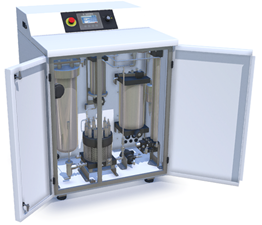Reducing H2 Lab Inventory with Small-Capacity Hydrogen Generators
Delivery and storage of commercial hydrogen in laboratory spaces may not always be practical due to availability of supply due to volume, cost, etc., safe handling, delivery security, area safety classification, and building regulations. When this is the case, water electrolyzer-based hydrogen generators can help by generating hydrogen only as needed, avoiding the need to store and handle hydrogen cylinders and tanks.
Cord-connected bench-top water electrolysis appliances generate the small H2 quantities typically needed by bench-top laboratory chemical analysis equipment. Larger capacity direct-wired systems may be specified where greater hydrogen generation rates are required, such as in sub-scale fuel cell testing.
Best safety practices for laboratory water electrolysis are to specify a safety agency certified/listed unit (e.g., ISO 22734, CSA/ANSI 22.2 No 22734, or IEC 61010-1) and install and operate it per the manufacturer’s instructions. These instructions typically are as follows:
- Install in a non-classified area that is ventilated with sufficient fresh air per manufacturer requirements – for instance, not in an enclosed, unventilated equipment closet.
- Vent waste hydrogen to a safe hydrogen exhaust vent (see Best Practices for Venting).
- Vent waste oxygen to a separate safe, compatible exhaust vent; or with smaller units, assure that local air ventilation provides sufficient dilution (< 23.5% O2 in air; see NFPA 2 2020 13.3.1.2.2).
- Interlock unit safety controls with your lab safety system alarms, such as loss of ventilation, combustible gas detection, and fire, to quickly stop hydrogen and oxygen generation in an emergency.


